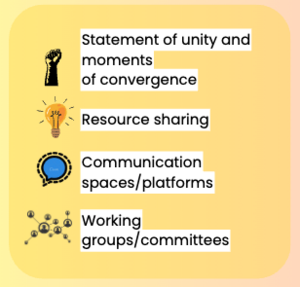Building coalitions
The content of this page presents a vision of intergroup work allowing teamwork to be accomplished between groups.
This page was created from the coalition training offered in French by the HUB. We hope to soon offer this training to our anglophone audience.
Beyond the traditional coalition
Here are some challenging aspects of traditional coalition work (based on HUB community members' experiences and past movement literature)
- slow process
- conflict over details
- groups with the most resources lead
- slow to adapt to changing context
- limits innovation
- concentration on narrow issues, subsequent dissolution
- many compromises
- renunciation of the specific framing of each group
- creation of false dichotomies: having to choose between different options (when it is possible to make several)
- inability to make decisions on certain key issues
These are notably linked to current practices of traditional coalitions, namely...
- the search for consensus
- the desire for the coalition to have a clear identity
- a negative conception of the diversity of objectives, tactics and horizons of struggle
The agile coalition is a coalition model that addresses these negative aspects of traditional coalitions.
Agile Coalition
Basis of agile coalitions
The agile coalition is a public or informal coalition that is united around a statement of unity and in which groups organize together, share certain resources, come together at key times and respect different tactics used. [1]
Basic ingredients

Unity Statement
A unity statement helps delineate why we are working together.
- The nature of the unity statement will impact the range of positions represented in your coalition.
- The more precise we are, the less risk we have of bringing groups together. The wider you are, the wider range of positions you find.
- Lesson learned from the Occupy movement. [2] [3] Coalition work recognizes the existence of disagreements and it is the statement of unity that provides the answer to the question “Why do we come together despite our disagreements
- By bringing together groups who agree on an issue, the space offered by agile coalitions can also be used to broaden perspectives on the issue and to show intersectional perspectives.
For example:
| “Direct action to end the HIV crisis” - ACT UP | “Against the government of owners and Bill 31” - FLIP | “Regularization for everyone, without exception” - Migrants Right Network | “In defense of biodiversity and against colonialism” - |
“Defund the Police, Invest in Communities” - |
“Between the end of the world and the end of their world, there is no alternative” - Earth Uprisings |
- ↑ https://docs.google.com/document/d/1lPvJr53uI_M5IzQmYS82h6xMX08jk4nGQ8s-mtqXN3E/edit
- ↑ https://www.stirtoaction.com/magazine-issues/issue-03
- ↑ Maeckelberg, Marianne. Horizontal Democracy Now: from the Alterglobalization Movement. 2012. 4 (1). Pages 207-234. http://www.interfacejournal.net/wordpress/wp-content/uploads/2012/05/Interface-4-1-Maeckelbergh.pdf